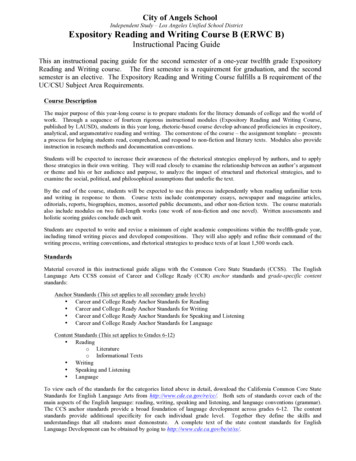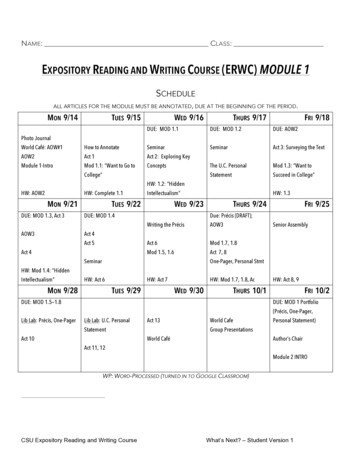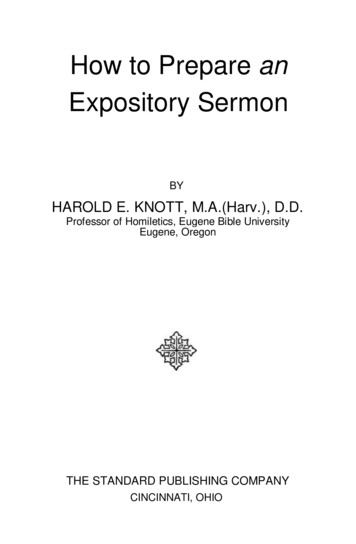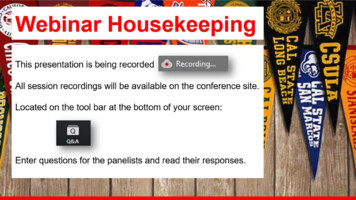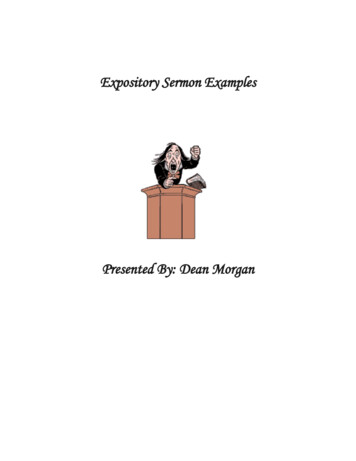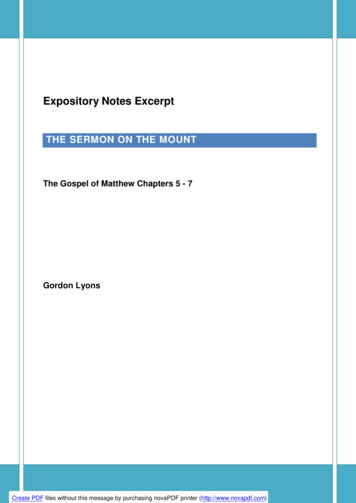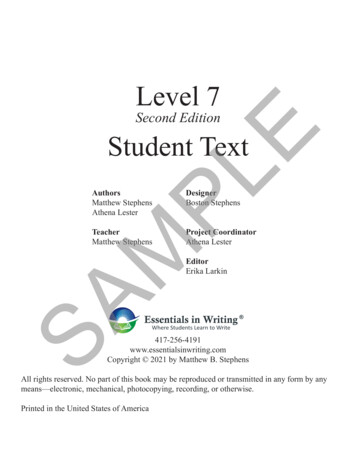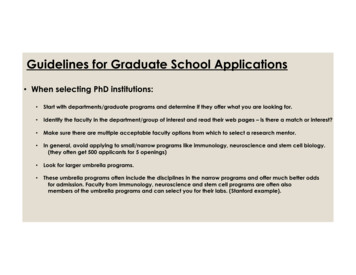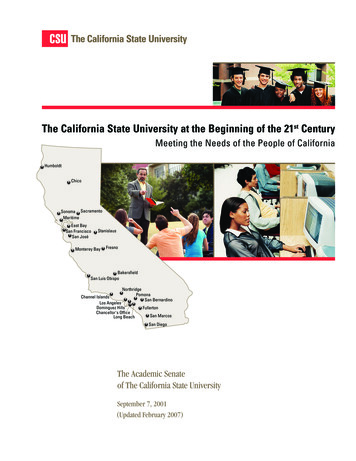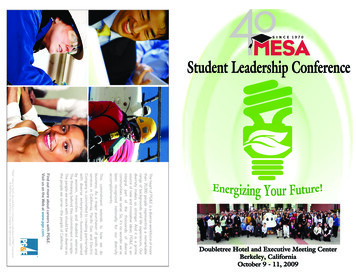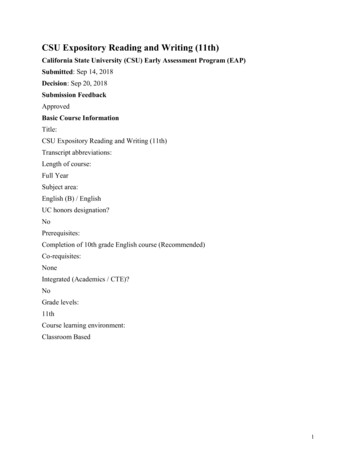
Transcription
CSU Expository Reading and Writing (11th)California State University (CSU) Early Assessment Program (EAP)Submitted: Sep 14, 2018Decision: Sep 20, 2018Submission FeedbackApprovedBasic Course InformationTitle:CSU Expository Reading and Writing (11th)Transcript abbreviations:Length of course:Full YearSubject area:English (B) / EnglishUC honors designation?NoPrerequisites:Completion of 10th grade English course (Recommended)Co-requisites:NoneIntegrated (Academics / CTE)?NoGrade levels:11thCourse learning environment:Classroom Based1
Course DescriptionCourse overview: The grade 11 Expository Reading and Writing Course (ERWC) engagesstudents in the discovery of who they are as persons, the realization of the ways in which theycan participate in society, and their development as critical consumers and effectivecommunicators within society. Teachers and schools build and personalize the yearlong courseby selecting from approximately 35 modules (instructional units) to meet rigorous, collegepreparatory learning goals in reading, writing, listening, and speaking for all students whilepromoting student interest and motivation. Employing a rhetorical, inquiry-based approach thatfosters critical thinking, student agency, and metacognition, the course includes six full-lengthmodules drawn from five categories: 1) American foundational documents; 2) American drama;3) full-length books; 4) research; and 5) contemporary issues (two modules). In addition, thecourse includes five concept mini-modules that address transferable skills applicable toconceptual development and practice across all modules, e.g., genre awareness, goal setting andself-assessment, rhetorical situation, Aristotelian appeals. The core structure of all the modules—the Assignment Template—progresses along an “arc” from reading rhetorically (preparing toread, reading purposefully, and questioning the text) to preparing to respond (discovering whatyou think) to writing rhetorically (composing a draft, revising rhetorically, and editing). By theend of the course, students will have read a range of literary and nonfiction text genres andproduced 10-12 culminating projects, including academic essays, research reports, creativewriting and performances, and multimedia presentations, from initial draft to final revision andediting.Note: The course materials listed with this submission represent the materials from a samplesequence of 11 modules for the categories as described above; they do not represent all possiblecourse materials.Course Content:American Foundational Document Module (Category 1)The four American foundational document module selections include the following: “The BigBreakup: The Declaration of Independence”; “March and the Civil Rights Movement, Then andNow”; “Segregation, Integration, Justice”; and “Speech in America.” Students read and analyzetexts such as the Declaration of Independence, the Bill of Rights, Lincoln’s Second InauguralAddress, the Gettysburg Address, or Brown v. Board of Education in conjunction with Web sites,videos, a graphic novel (March, Book Three), or other contemporary articles related to thethemes of the selected module. In each module, students relate historical American documents toissues of the day and synthesize their understandings to create an argument for the role theDeclaration of Independence should have in our society today; what the civil rights movementshould look like today; or how best to integrate people of different backgrounds or abilities, orstudents identify an action to solve a problem in the school, community, or world.Unit Assignment(s): Sample Assignment from “The Big Breakup: The Declaration ofIndependence”:Activity 28: Considering Your Task and Your Rhetorical SituationWhat is or should be the role of the Declaration of Independence in our country today? Takinginto account the survey your class did in Activity 17, the two articles from the Washington Post,and the text of the Declaration itself, write an essay in which you define the role that the2
Declaration should have, support why it should have this role, and discuss some concrete thingsthat could be done to achieve it.There are many different positions that could be taken. One could argue, for example, that theDeclaration achieved its purpose at the time, but now that we are a separate country, its job isdone. On the other end of the spectrum, one could argue that it expresses the hopes and dreamsof our country and should be remembered and consulted by everyone. If the latter is the case,both Gerson and NPR have suggested ways that people might keep the ideas of the Declarationin the forefront of the conversation, though their ideas may not be the best ones. Whateverposition you take, support your arguments with words from the Declaration itself, from thediscussions you have had in class, and from the two articles. You may also want to considerother sources.You may find that some of the paragraphs you wrote in doing the activities in the module can bereworked to fit into your essay. Look back through your notes to see if there is material you canuse.a. Students will synthesize their readings and collaborative discussions in order to take aposition expressed through an argumentative essay.b. Written essayc. Students will learn to engage in collaborative discussions, synthesize multiple perspectives,analyze writing prompts and their rhetorical situation (audience, occasion, purpose), gatherevidence and develop a position, and argue effectively in writing creating a product frominitial drafting through final revision and editing using classroom technology, such as Googleclassroom, as appropriate.American Drama Module (Category 2)The two American drama module selections include “The Crucible: A Power Play” and “SoWhat’s New? Zoot Suit and New Dramatic Potentials.” Students read and analyze one of the fulllength plays and, for The Crucible, a supplementary article and Web sites. Students performdramatic readings of Zoot Suit and view a performance online. In the culminating task for TheCrucible, students consider the core question—How is power used and abused?—and write anessay evaluating a character from the play or write a one-act play featuring a contemporarycharacter of their invention. For Zoot Suit, students write a third act for the play exploring apresent-day iteration of one of the play’s characters.Unit Assignment(s): Sample assignment from “The Crucible: A Power Play”:Activity 23: Considering Your Task and Your Rhetorical SituationFor the culminating assignment in this module, you will write an essay addressing the corequestion: How is power used and abused?Prompt 1Background: The Crucible presents a series of power plays between characters and groups ofdifferent status. Throughout the play, education, title, luck, age, gender, strength, wealth, andsocial connectedness confer power on individuals. In this essay, you will examine powerbrokerage—how characters get, use, and maintain power.3
Writing Task: Choose a major character from The Crucible, and using the French and Raven’sFive Forms of Power article, evaluate how that character assumes, utilizes, and maintains (orloses) power throughout the play. What power bases do they use? How do they use them? Howcould they have used a different power base to act with more humanity in the story and mitigate,or lessen, the abuse of power by themselves or other characters in the play? Make sure that yourefer to your character’s development of power throughout the play. Cite your evidence from atleast two acts of the play. Make sure that all your assertions are documented by correctly citedfacts (quotes) from your sources and supported with the quote and your rationale. The rationaleshould backup, or defend, your assertions.Prompt 2Writing Task: Arthur Miller wrote The Crucible in response to his concerns about McCarthyism,the practice of making accusations of subversion or treason without proper regard for evidence.Choose a contemporary group that is currently at risk of suffering from similar abuses of power.Create a character that represents this potentially persecuted group. Write a one-act playfeaturing this character. Your dramatic arc should demonstrate how humanity could mitigate orfail to combat abusive power.In selecting your topic, consider the timeliness of your message. What topics or issues areparticularly relevant in the current social and historical context? How might your make use ofthis kairotic moment?After writing your act, complete a one-page reflection in which you address the following: Inyour act, what power base(s) did your characters use? How did their actions mitigate the abusesof power? How is your act particularly relevant to our current social and historical context? Howare your characters and situations inspired by those of The Crucible?a. Students will engage in collaborative discussions and conduct a character analysisconsidering the question at issue in order to take a position expressed through anargumentative essay. OR Students will create a character based on a contemporary issuerelated to themes from The Crucible and write a one-act play.b. Written essay OR one-act playc. From this activity, students will learn to engage in classroom discussions collaboratively,conduct a character analysis, gather evidence from the text, analyze writing prompts and theirrhetorical situation (audience, occasion, purpose), develop a position, and argue effectively inwriting. OR Students will learn to build on the themes of the play to create a character andwrite a narrative piece. Students learn to create a written product from initial drafting throughfinal revision and editing, using classroom technology, such as Google classroom, asappropriate.Full-Length Book Module (Category 3)The four book module selections include the following: the great American novel, The GreatGatsby; the memoir of a young immigrant, The Distance Between Us; the book of linked shortstories based on the Vietnam War, The Things They Carried; and the story of learning,persistence, and innovation during the Malawi famine, The Boy Who Harnessed the Wind.Students read and analyze the selected book considering its literary and rhetorical features andquestions at issue. Students typically engage in activities for of each section of the book—oftenwith a major writing assignment at the conclusion of each. For example, The Great Gatsby4
module requires students to complete four writing assignments: a letter to Nick Carraway aboutthe social landscape of a student’s own neighborhood, an essay about Gatsby’s true identity, adefinitional essay about love, and an essay about how the novel has affected each student’sattitudes toward literature and life.Unit Assignment(s): Sample assignment from “The Things They Carried and the Power ofStory”:You have been analyzing, exploring, and experimenting with the original literary form that TimO'Brien invented for The Things They Carried. Write a fictionalized version of an event similarto the one you have experienced, using two or more of O’Brien’s writing moves to convey thefelt truth of this event (the point you are trying to make). You may want to adopt one of yourletters or stories for this purpose—or choose another memory from your backpack. If you wouldprefer, you can reimagine an event from the life of someone you know, such as a parent orgrandparent.Simulate O’Brien’s approaches, but make this narrative your own. You might create a fictionalprotagonist who shares your name and write a narrative and descriptive passage about what“you” see and think and do, or you can create two or more versions of this same event that aretold from multiple perspectives or with differing styles.Be sure to at least use the following two O’Brienesque techniques in your story:1. A central indelible (unforgettable) image or moment that conveys the strongest core of thememory or the truth of the story. This image should be revisited several times and be toldwith variations. See the following stories for models of a repeated central image: “The Things They Carried” (death of Ted Lavender) “How to Tell a True War Story” (death of Curt Lemon) “The Man I Killed” / “Ambush” / “Good Form” (the killing of the “man”) The “field stories in readings 6 and 7 (the death of Kiowa)2. Repetition of the exact same phrasing or words. This could be combined with the centralimage, as O’Brien does in describing “the man [he] killed.”a. Students will reflect on classroom discussions and the stories read in the book and create theirown narrative of an event.b. Written narrativec. Students will learn to analyze literary text and incorporate imagery and effective diction intheir own narrative writing, using classroom technology, such as Google classroom, asappropriate.Research Module (Category 4)The two research module selections include “Service and Sacrifice” and “Daily Challenge:Mental Illness in Our Lives.” For the first, students read the full-length work, Claudette Colvin:Twice Toward Justice, and then conduct primary and secondary research on a community changemovement of their choosing. They consider how change occurs and explore how to tell the storyof a movement in their culminating task. For the second, students investigate issues surroundingPost-Traumatic Stress Disorder (PTSD) and other mental illnesses. They read and analyze a5
newspaper account of a veteran with PTSD and then research a mental illness in order to writeand perform a public service announcement.Unit Assignment(s): Sample assignment from “Service and Sacrifice”:Activity 16: Considering Your Task and Your Rhetorical SituationProject Overview: We have been reading about Claudette Colvin and the role she played indesegregating buses in Montgomery, AL, and in the nation. Our discussions of the book focusedon her role in supporting this change, the risks and rewards of her actions, and the overalltrajectory and kairos that are a part of such major social change. We also compared these eventswith other community change events. The point of this reading and these discussions is for us toconsider what role we play in our communities in making change, and for us to consider the veryimportant notion of the relationship between risk and reward in community action contexts.Prompt 1: For this writing project assignment, building from Activity 14, you will analyze howchange happens socially and rhetorically in communities. Drawing on the book about Colvin, aswell as at least one other community change event (locally or nationally), highlight the importantmoments that led toward change for the residents of Montgomery as well as what moments ledthe people of another movement to make change and compare how moments in both situationscreated opportunities for change. Be sure to focus not only on events, but also the timing of thoseevents, the genres of the events (for example, community meetings, speeches, flyers announcingevents, maps of pick up and drop off locations, schedules and maps for people who needed rides,legal documents, books or articles that report on the event in the aftermath, etc.), the audienceand purpose of people taking action, the opportunities that people took to take action, and thesocial factors that contributed to how events unfolded (for example, laws like Jim Crow that setthe stage for activism). You also need to include multimedia elements as a way to enhance themeaning and analysis of your reflection. The point of this writing is to reflect with evidence, bothtextual and multimedia, about what it means and what it takes to make meaningful and largescale social change.Prompt 2: For this writing project assignment, building from Activity 14, choose an action thathappened in your local or national community that should be documented and told. Interviewknowledgeable residents of your community. Search local newspapers for information about howthat story unfolded. Visit a local historical society or museum to brainstorm ideas or to findartifacts (that you can photograph and include in your text). Drawing on your experience readingabout Colvin and the Montgomery Bus Boycott, use similar writerly practices and genreelements as Hoose used in his book to tell your own community’s story.For both writing projects, you need to include at least five sources, which must include at leastone primary, one secondary (the texts we read in class or that you read for homework can becounted toward these four), and one multimedia. Works cited needs to be in MLA or APAformat.a. Students will build on classroom discussions and other activities to research an issue eitherthrough secondary sources (prompt 1) or primary sources (prompt 2) in answer to thequestions posed and develop a coherent written analysis.b. Written reportc. Students will learn to research an issue either through secondary sources (prompt 1) orprimary sources (prompt 2) in answer to the questions posed, synthesize and document6
sources, and present a coherent written analysis, using classroom technology, such as Googleclassroom, as appropriate.Issue Module (Category 5)The 14 issue module selections include the following: “Chance Me: Redefining Merit”;“Changing Minds: Thinking About Immigration”; “Civil Disobedience From Thoreau toPresent”; “The Danger (and Power) of a Single Story”; “Generation to Generation: Learningfrom Each Other”; “A Headache Becomes a Death Sentence: The NFL’s Arguments on theConcussion Crisis”; “Human Impact on Climate”; “Nonconformity: Yay or Nay?”; “Poetry isAmong Us”; “Racin’ America”; “The Really Big One” (about earthquakes or other naturaldisasters); “Rhetoric of the Op-Ed Page”; “Teenage Sleepers”; and “What’s Next? ThinkingAbout Life After High School.” Teachers and schools select at least two issue modules to teach.Based on the modules selected from the other categories, teachers and schools consider thebalance of text genres, writing assignment types (argumentative, informative, narrative),opportunities for multimedia and oral presentations, assignment length, state standardsaddressed, and students' needs and interests in order to select the most appropriate issue modules.All modules include extensive collaboration and discussion, examination of vocabulary, textbased critical thinking questions, and analysis of rhetorical effects. Many of the issue modulesengage students in using technology to identify additional sources of information and most offerchoices of issues and assignments that students explore beyond the initial readings and assignedactivities.Unit Assignment(s): Sample assignment from “Changing Minds: Thinking AboutImmigration”:Activity 20: Considering Your Task and Your Rhetorical SituationRead the writing assignments for this module and make notes in response to the questions below:Academic EssayPrompt 1: Changing Other People’s MindsWhat can we learn from Ropeik and Machado in order to try to change the minds of people who“hold tenaciously” to myths about immigration?Write an essay to be posted on a Web site for people interested in issues of changing minds aboutimmigration such as the ADL Web site. Make an argument about how to go about changingpeoples’ minds on controversial topics like immigration. Use evidence from Ropeik’s andMachado’s articles, from “Myth and Facts About Immigrants and Immigration,” and your ownobservations and/or reading.Make clear whose ideas or words you are using by including the author’s names and titles of thearticles. You do not need to include in-text citations (page numbers) or a reference list. If youwish to cite discussions in class and the role the Norms for Civil Discourse that your classcreated, do not use the names of your fellow students.Prompt 2: Changing My MindAs a high school student, you may be an immigrant, from a family that includes immigrants orbe surrounded by immigrants and the children of immigrants. You are inundated withinformation and misinformation about immigration.7
Write an essay to be published in your school newspaper about how your own views aboutimmigration have evolved in response to new information and experiences. Use evidence fromboth Ropeik’s and Machado’s articles and from “Myth and Facts About Immigrants andImmigration” to explain the stages in the evolution of your thinking and to argue for your currentview about immigration.You must make clear whose ideas or words you are using by including the author’s names andtitles of the articles. You do not need to include in-text citations (page numbers) or a referencelist. If you wish to cite discussions in class, do not use the names of your fellow students.To prepare to write, take notes on your responses to the following questions. Now that you have read the texts for this module, what is your position about what ittakes to change someone’s mind on a controversial topic like immigration? What will your purpose be in writing this essay? Who will read your essay? How will you take into account your readers’ knowledge,values, and assumptions? How will you engage in civil discourse and be respectful ofalternative viewpoints? How will you develop your own credibility as someone knowledgeable on the subject ofopinion formation and immigration at this time in our country’s history? How will you balance your appeal to your readers’ emotions with your need to providesound factual information about immigration?a. Students synthesize their readings and discussions to address the final writing prompt. Bothprompts ask students to develop an argument.b. Argumentative writing for a Web posting or school newspaperc. Students will learn to synthesize multiple perspectives, analyze writing prompts and theirrhetorical situation (audience, occasion, purpose), gather evidence and develop a position,and create a written product from initial drafting through final revision and editing, usingclassroom technology, such as Google classroom, as appropriate.Sample assignment from “The Danger (and Power) of a Single Story”:Activity 22: Considering Your Task and Your Rhetorical SituationAfter you listen to your teacher read the prompt, reread it and circle any unfamiliar words.Annotate the prompt with numbers indicating the steps you need to complete. Your class willwork together to create a list of strategies to achieve each step.Prompt 1: What is a dangerously narrow single story from a community you know? Perhaps it’sone you believed until you learned more about the people involved, or maybe it’s a single storysome people believe about you or your family. Develop a narrative (fiction or nonfiction) to helpcomplicate this simplistic belief for a specific audience. If your narrative focuses on acommunity different from your own, position yourself as an ally rather than co-opting theperspective you’ve selected. Anticipate your audience’s needs by selecting a medium, genre, andstyle that will invite interest and empathy.Prompt 2: In her TED Talk “The Danger of a Single Story,” author Chimamanda Ngozi Adichieargues that stories have great power, both “to dispossess and to malign,” and “to empower and to8
humanize.” Choose a story from this module and decide whether, in its craft and appeal to aspecific audience, it has achieved the power Adichie describes. Has it complicated a single storyfor an audience that previously held a simplistic view? Does it fall short by appealing only toaudiences already familiar with the complex subject? Or does it wield a darker power,reinforcing a stereotype or maligning a marginalized community? Using specific evidence fromAdichie’s speech, your analysis of the short story, and your investigation of the story’s intendedaudience, create an argument to convince your classmates and teacher that the story you selectshould be upheld as an example of literary social justice or rejected due to its limited appeal orpurpose.a. Students synthesize their readings and discussions to address their choice of final writingprompt. One prompt asks students to create a narrative, and the other asks them to develop anargument.b. Narrative story based on the issues addressed in the module or an argumentative essay to bepresented to the classc. Students will learn to synthesize multiple perspectives, analyze writing prompts and theirrhetorical situation (audience, occasion, purpose), gather evidence and develop a position,and create a written product from initial drafting through final revision and editing, usingclassroom technology, such as Google classroom, as appropriate.Concept Mini-Module (Category 6)The nine concept mini-module selections include the following: “Introducing ERWC 11:Reflecting on Learning and Using Portfolios”; “Introducing the Rhetorical Situation”; “ThreeWays to Persuade”; “Email, Text, or Call? Learning to Write through Genre Awareness”;“Becoming Assessment Savvy”; “Learning for Fun and Future”; “The Classical Pattern ofPersuasion”; “The Toulmin Model of Argumentation”; and “Final Reflection on Learning: TheERWC 11 Portfolio.” These mini-modules take a few days to a week or two to teach and addressmany key or foundational concepts to ERWC. They focus on ideas considered thresholdconcepts for the course that will be used in most modules as well as in other disciplines. Themost critical of these are the rhetorical situation (audience, purpose, occasion); Aristotelianrhetorical appeals (ethos, pathos, and logos); metacognition; and transfer of learning. Theconcluding mini-module, “Final Reflection on Learning,” provides opportunities for students tolook back on the year’s learning and review what they’ve discovered and aspects of theirreading, writing, listening, and speaking that may call for further development as they preparefor college and careers. Both the introductory and concluding portfolio mini-modules directlyaddress elements of Universal Design for Learning, including goal setting, formative assessment,student self-assessment, and metacognition.Unit Assignment(s): Sample assignment from “Learning for Fun and Future”:Activity 4: Considering Your Task and Your Rhetorical SituationThe writing task for this module is to write a letter to another student in your class, using yourunderstanding of detect, elect, and connect to suggest how your colleague can apply skills theyare learning in their English class to one of their other classes. In this case, you will be doing thework of detecting for your colleague, and you will suggest ways that they can make connectionsbetween classes, but it will be up to them to elect to follow your advice, so make it convincing.9
In order to make your advice convincing and helpful, you will need to interview your colleagueto gather information and consider the connections you can help them make. They may be moreinclined to use your advice if the class you suggest they apply their English skills in is one theyespecially enjoy or perhaps is one in which they struggle. Here are some questions you might askto get you started. You will probably need to ask more to get all of the information you need.Make sure you take careful notes of your interview. What classes are you taking other than English? Which subject do you find the most interesting and enjoyable? In which class do you struggle the most? What kinds of reading do you do in your class? What kinds of writing do you do in your class? What other kinds of activities do you do?Because you want to be helpful to your colleague, try to use your imagination to look forunexpected ways they might use English skills to deepen their learning in whichever class youchoose to advise them about.a. Students interview their classmates and write a persuasive letter suggesting how they cantransfer what they learn in English to other settings.b. Written letterc. Students will learn to synthesize what they have learned about transfer and apply it to aclassmate's own situation by writing a letter of advice. They will learn to analyze theirrhetorical situation (audience, purpose, occasion) to write the most effective letter, usingclassroom technology, such as Google classroom, as appropriate.Sample assignment from “Three Ways to Persuade”:Activity 8: Considering Your Task and Your Rhetorical SituationConsider the following quotations from Aristotle in defense of rhetoric:1. Rhetoric is useful because the true and the just are by nature stronger than their opposites andif judgments are not made in the right way, the true and the just will be defeated by theiropposites.2. Even if we were to have the most exact knowledge, it would not be easy for us in speaking touse it to persuade some audiences. Speech based on knowledge is teaching, but teaching isimpossible with some audiences; rather it is necessary for . . . speeches as a whole to beformed on the basis of common beliefs.3. It would be strange if an inability to defend oneself by means of the body [such as bylearning boxing] is shameful, while there is no shame in an inability to use speech.4. If it is argued that great harm can be done by unjustly using such power of words, thisobjection applies to all good things except virtue, and most of all useful things like strength,health, wealth, and military strategy; for by using these justly one would do the greatestgood, and unjustly, the greatest harm. (Kennedy 34-35)10
We have a saying, “The facts speak for themselves.” In quotation number 1, Aristotle is sayingthat sometimes the facts need a little help from rhetoric. Taking this quote and the other threeinto account, does Aristotle make a good case that we should study and use rhetoric? Or is theuse of rhetoric, especially ethos and pathos, deceptive and bad? Write a short essay in which youtake a position on the use of rhetoric and analyze the four quotations from Aristotle.a. Students reflect on classroom discussions and other activities to write an essay taking aposition on the use of rhetoric.b. Written essayc. Students will learn to synthesize what they have le
CSU Expository Reading and Writing (11th) California State University (CSU) Early Assessment Program (EAP) Submitted: Sep 14, 2018 . Decision: Sep 20, 2018 . Submission Feedback . Approved . Basic Course Information . Title: CSU Expository Reading and Writing (11th) Transcript abbreviations: Length of course: Full Year . Subject area:
